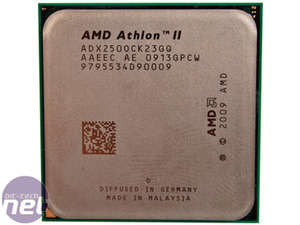AMD Athlon II X2 250 CPU
Manufacturer: AMDUK Price (as reviewed): £61.85 (inc. VAT)
US Price (as reviewed): $87.00 (ex. Tax)
During Computex this year, AMD announced not only its most complex CPU to date - the six-core Istanbul - but also some cheap and cheerful additions to its value, dual-core lineup. Enter the next generation Athlon - the Athlon II. Or, perhaps the Athlon XI or something, since we've had slot, socket, K7, K8, K10 and now K10.5 Athlons. The "II" (two) branding is meant to keep things in stroke with the Phenom IIs and the latest 45nm, K10.5 cores.
What makes these Athlons and not Phenoms though is the complete lack of L3 cache - only a traditional 128KB of combined L1 and 1MB of uniform L2, per core, to keep the data in. Since these caches are exclusive of one-another, there's no anti-snoop filter that the L3 cache would naturally provide, so cross core traffic and memory nosing is increased, making things respectively slower.
The offset of which is a set of whacking great big core clocks at a full fat 3.0GHz, with the integrated memory clock running at 2.0GHz, the latest HyperTransport 3.0 specification (4.0GT/s or 2.0GHz). This new CPU plugs into the latest Socket AM3, but it only supports memory speeds of DDR2-800 and DDR3-1066.
The other limitation of the Athlon IIs is that there will be no Black Editions with unlocked CPU multipliers. This means that overclocking has to be achieved the old school, and harder way of increasing the HT clock, while simultaneously balancing total HT clock and other things it affects like memory clocks as well. Fun, fun, fun!
- Clock Frequency:
Although Socket AM2+ has been around for several years now, we reckon many readers will still be running a dual-core Athlon X2 as the first generation Phenom CPUs were so disappointing. The big question therefore is whether the Athlon II X2 250 is a worthwhile upgrade from one of these older CPUs or one of the more recent cut-price CPUs such as the Phenom X2 7750 Black Edition.
However, the Athlon II X2 250 is much more flexible than its predecessors because it’s compatible with both Socket AM2+ and Socket AM3 motherboards. This is great news for such a low price CPU as cheap good-quality Socket AM3 motherboards have finally begun to appear in the last few weeks. The only downside in this equation is DDR3 which, while coming down in price all the time, is currently still a little more expensive than DDR2. Still, given how much better Socket AM3 motherboards overclock than their Socket AM2+ predecessors – it’s well worth thinking about using the Athlon II X2 250 with a Socket AM3 motherboard.
At £62, the Athlon II X2 250 is nearly £11 more expensive than the very popular Pentium Dual Core E5200 we've been recommending in our buyer's guide for many months. The question is; does the higher frequency, DDR3 support and smaller manufacturing process of the Athlon II X2 250 yield greater or comparable overclockability to the E5200, and what is their respective performance for the pound?
Has AMD produced a better bargain processor than the E5200 or is Intel's little cheap screamer still the best budget CPU?

MSI MPG Velox 100R Chassis Review
October 14 2021 | 15:04











Want to comment? Please log in.